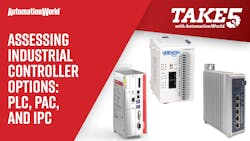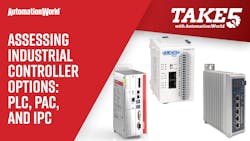Assessing Industrial Controller Options

Quick hits:
- How PLCs enable automated systems to be altered via software rather than hardware changes.
- Why PACs are often used when integrating capabilities such as safety, motion, distributed I/O, and network communications.
- How IPCs can run multiple applications in addition to control programs.
Welcome to Take Five with Automation World. I’m David Greenfield, Director of Content, and today we’re going to look at the controller options facing OEMs and end user automation equipment buyers.
It’s been a little more than 50 years now since the invention of the programmable logic controller, or PLC. And though PLCs are essentially very basic computers used to control machine functions, they allow engineers to develop, modify, and expand the functionality of control systems through software, rather than hardware changes to the system that were required in the past with electromechanical relays. This capability really set the stage for the future of automation and control and many of the advances we’re seeing today.
But just as no technology is static, neither is the PLC. Over the years, suppliers added new capabilities to basic PLCs to address various end user needs. Some of these new functionalities included integrated servo and drive control, network communications, advanced process control, and the ability to handle multiple programming languages. With all these new capabilities, the PLC became more than just a basic controller, and that’s how the term programmable automation controller—or PAC—came into being. Basically, this term better reflects the expanded—and still expanding—capabilities of controllers.
Though controller suppliers use the term PAC to distinguish these advanced controllers from their more basic PLCs, the boundaries between the two have become somewhat blurred. After all, with all the software and chip advances that have occurred over the past few decades, unless you’re looking at the simplest controller to handle the most basic control functions, you’re likely looking at a PAC. Both PLCs and PACs serve the same general purpose, but PLCs are typically specified for very basic discrete control operations, while PACs tend to be preferred when complex equipment features or automation infrastructures are required.
Explaining all this a bit further, Nate Kay with system integrator Martin CSI says: Most classic PLCs use a memory-based form of programming, where the addresses are tightly coupled to a physical memory structure. But PACs let you focus on writing in the programming language you prefer while they handle memory management in the background. PACs also allow tag-based programming, which increases the flexibility and scalability of the controller by allowing tags to be assigned to functions before tying them to specific I/O or memory addresses.
That’s why PACs are often used for controlling larger processes and integrating things like safety, motion, distributed I/O, and network communications. Using a PLC for these applications would generally require adding hardware modules to perform those types of tasks.
The third controller option facing buyers is the industrial PC or IPC. Frank Burger with system integrator Avanceon says these software-based controllers feature similar programming environments and firmware as a PAC, but they’re hosted on a regular computer platform. The advantage here is that IPCs can run multiple applications—not just the control programs. For example, you can run databases, protocol converters, and recipe managers on an IPC, as well as your SCADA and MES software.
But, like any PC, IPCs can require more frequent updates and patches and may not be able to operate effectively for as long as a traditional PLC.
IPC suppliers, however, maintain that PC-based control can be just as effective and dependable as PLCs and PACs in demanding applications such as high-speed motion control—and they point to their many decades of wide use across industry as evidence of this.
Beyond machine control, IPCs are also used in cases where there may not be an existing server or network infrastructure. Since they have the full features of a PC, they can be used for these kinds of applications. They’re also used where processing power is needed at a specific location, such as with machine vision.
Because each control system option is unique, many industry experts advise consulting with a trusted system integrator before making a choice. Andrew Abramson with system integrator Grantek, says an integrator can help you weigh the costs and benefits of the different architectures, including initial capital investment and ongoing maintenance costs, as well as the risks and functionality inherent to each of these different controller options.
